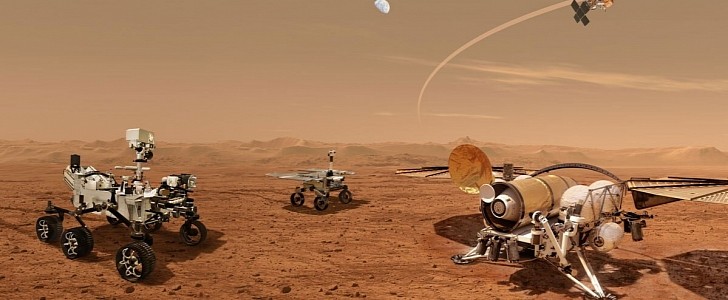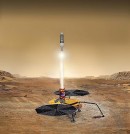At the time of writing, there are a number of ambitious space exploration projects in the works. The most high-profile and closest to becoming reality is the Artemis Moon program. But probably the most far-reaching is the Mars Sample Return mission.
The most recent rover to be sent to Mars, Perseverance, is already at work on the Red Planet. Soon, it will start collecting samples of soil and depositing them in key locations, from where another rover will retrieve them, load them onto a rocket, and have them sent to Earth.
Described by NASA as “the most sophisticated endeavor ever attempted at the Red Planet,” the Mars Sample Return will require far more technology than ever used before on an alien world. It will rely on a rocket to launch from Earth, a descent vehicle to reach the surface of Mars, a rover to collect the samples, an ascent vehicle to depart the neighboring planet, and a re-entry capsule to deliver pieces of Mars to Earth.
Most of this tech will be developed by Lockheed Martin. The company already announced it has received a $194 million contract to design, build, test and deliver the Mars Ascent Vehicle (MAV), “the first-ever to lift off from the surface of another planet.”
But that’s not the only thing Lockheed will do. In exchange for $35 million, the company will also be responsible for the “cruise stage that will power and steer the Mars-bound journey of the lander.“ The money will be used to “produce the cruise stage and its comprehensive elements, including the solar arrays, structure, propulsion and thermal properties.”
The smallest sum, $2.6 million, will go towards the creation of the so-called Earth Entry System, which is, in essence, the capsule the samples will be stored in, while coming down toward our planet’s surface, hopefully unharmed.
That’s a total of a little over $231 million for some of the most important pieces of hardware to be made for the Mars Sample Return mission, departing no sooner than 2026.
Described by NASA as “the most sophisticated endeavor ever attempted at the Red Planet,” the Mars Sample Return will require far more technology than ever used before on an alien world. It will rely on a rocket to launch from Earth, a descent vehicle to reach the surface of Mars, a rover to collect the samples, an ascent vehicle to depart the neighboring planet, and a re-entry capsule to deliver pieces of Mars to Earth.
Most of this tech will be developed by Lockheed Martin. The company already announced it has received a $194 million contract to design, build, test and deliver the Mars Ascent Vehicle (MAV), “the first-ever to lift off from the surface of another planet.”
But that’s not the only thing Lockheed will do. In exchange for $35 million, the company will also be responsible for the “cruise stage that will power and steer the Mars-bound journey of the lander.“ The money will be used to “produce the cruise stage and its comprehensive elements, including the solar arrays, structure, propulsion and thermal properties.”
The smallest sum, $2.6 million, will go towards the creation of the so-called Earth Entry System, which is, in essence, the capsule the samples will be stored in, while coming down toward our planet’s surface, hopefully unharmed.
That’s a total of a little over $231 million for some of the most important pieces of hardware to be made for the Mars Sample Return mission, departing no sooner than 2026.







